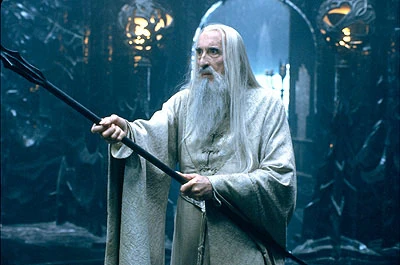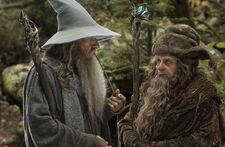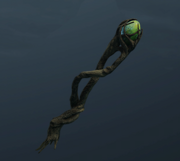A wizard's staff (pl. staves) was the primary tool, power conduit, and strategic weapon of the Istari, which might have also served as a symbol of their power or rank. Since there were a total of five Istari in the Order of Wizards, there were only five known staves employed at any one time.
Staves in Tolkien's Legendarium
Gandalf the Grey
Gandalf the Grey bore a wooden staff throughout The Hobbit and The Fellowship of the Ring. The crown of the staff appeared to possess some means of illuminating pitch-dark areas, such as the tunnels of Goblin-town and Khazad-dûm, though exact details are not specified. Near the bottom of Gandalf's staff was a nail that he had supposedly hammered through it. In The Hobbit and The Fellowship of the Ring, Gandalf is stated to use this nail as a tool for carving the cirth letter "G" on objects to mark his presence, such as on the door of Bag End and some stones in the Tower of Amon Sûl. This staff eventually broke, when Gandalf struck the Bridge of Khazad-dum, causing it to collapse beneath the feet of Durin's Bane.
Gandalf the White

After being revived as the White Wizard, Gandalf was given a new staff of power by Galadriel at Lothlórien. Gandalf's power and wisdom were greatly increased following this rebirth, allowing him to more directly aid the Free Peoples of Middle-earth in their need, and to denounce and overthrow the treacherous Saruman (who by then had refused the title of "the White"), becoming the head of both the Order of Wizards and the White Council in the process. Gandalf the White's staff was of ash wood, and presumably white in colour.
Saruman the White

Saruman the White's staff is described as being black in colour. After the Battle of the Hornburg, Gandalf the White and his companions made their way to Isengard. Due to Saruman's treachery against Middle-earth, his staff was broken at Gandalf's command, and its crown fell at Gandalf's feet.
Radagast the Brown
As one of the Istari, Radagast possessed a staff of power, but no description is given of its appearance or powers.
Blue Wizards
Like the previous wizards, the Blue Wizards Alatar and Pallando had staves of their own which would have aided them in their travels. As with Radagast, no description is given of their staves' designs or powers.
In adaptations
Peter Jackson's The Lord of the Rings and The Hobbit trilogies

Gandalf the Grey
Gandalf's staff first appears chronologically in The Hobbit: An Unexpected Journey. It has been described by the Wētā Workshop propmakers as an "opening flower," and is of elvish design. Indeed, the crown of this staff somewhat resembles the staff of Gandalf the White, when one observes the similar shape embedded in the crown. Gandalf uses this staff as a tool to carve his "G" rune on Bilbo's door, and to illuminate the tunnels of Goblin-town and the High Fells of Rhudaur. He also uses it offensively to ignite giant pine cones for use as projectiles; to conjure a wave of bright energy that sends Goblins flying; to dislodge large chunks of stone in Goblin-town and Dol Guldur; to kinetically repel Azog the Defiler and his Orcs, and to conjure a shield of energy that defends him from Sauron's dark magic.
It is upon this last usage that this staff is destroyed by Sauron in Dol Guldur, where it gradually disintegrates in Gandalf's hands. After escaping Dol Guldur with the help of Radagast, the Brown Wizard gives Gandalf his own staff as a replacement, stating that Gandalf will have greater need of it in the Battle of the Five Armies. Whilst attempting to use the staff against a troll in the battle, however, Gandalf runs into complications when the turquoise crystal inserted in the top of the staff fails to respond to his magical incantation. Gandalf then dodges the troll's attacks and attempts a strike with the staff, which also fails to have any effect. As the Battle of the Five Armies continues, the root-like twigs on the crown of the staff are completely broken off, leaving the staff in its state seen at the beginning of The Lord of the Rings: The Fellowship of the Ring. Though not easily seen in The Fellowship of the Ring, Gandalf uses the slot in the staff's crown (which previously held Radagast's turquoise crystal) to store his smoking pipe. He has also hammered another large nail through the staff, though this nail is removable as he is seen using it as a tamper for his pipe in The Hobbit: The Battle of the Five Armies.
Gandalf used this staff until Saruman confiscated it in their duel at Orthanc. Elrond then gives Gandalf another wooden staff in Rivendell, which could hold an illuminating crystal with the power to brighten or dim at Gandalf's will. This is shown to be removable - Gandalf places a clear crystal of unknown origin into the crown of the staff when the Fellowship first enters the Doors of Durin. Unlike in the book, this staff remains intact when Gandalf uses it to destroy the Bridge of Khazad-dûm during his battle against Durin's Bane. However, Gandalf still loses it when the Balrog drags him into the abyss.
Gandalf the White
The staff of Gandalf the White is of Elvish design, with a pyramidal structure and Elven arches that create a hollow, similar to Gandalf's original staff. This staff was given to him by Galadriel in Lothlórien and enhanced his powers upon his return. In The Return of the King, Gandalf uses his staff to create a wide beam of light to repel the fell beast-riding Nazgûl's attack on Faramir's company of soldiers outside Minas Tirith. In The Lord of the Rings: The Return of the King Extended Edition, Gandalf the White's staff is broken in a scene in which he faces off against the Witch-king of Angmar atop one of Minas Tirith's walls. Gandalf appears to try to deflect some form of attack from the Lord of the Nazgûl's flaming sword, which breaks the staff into pieces that immediately vanish. Gandalf is later seen holding a final staff at the Grey Havens that is almost identical to his previous one, though it is considerably longer in length.
Saruman the White
In Peter Jackson's The Lord of the Rings trilogy, Saruman's staff is black and appears to be made of metal. The crown of the staff resembles the pinnacle of Orthanc and holds some form of orb, which is white in colour. In The Hobbit: The Battle of the Five Armies, Saruman uses his staff to battle with the shades of the Nazgûl in Dol Guldur, deflecting their attacks. The orb in his staff is seen to glow white whilst he attacks the Nazgûl, showing his power and magical skill. In The Lord of the Rings: The Return of the King Extended Edition, Saruman again uses his staff, this time to send a jet of fire down on Gandalf the White: however, Gandalf resists it and says, "Saruman, your staff is broken." Saruman's staff is then seen to crack (exposing a bright light from inside it), before breaking into pieces, which immediately vanish.
Radagast the Brown
Radagast's staff is fashioned from an upturned sapling, reflecting his rustic personality. The staff bears an undetermined mark that somewhat resembles the Gondolinic cirth rune "Y", but that Radagast used as a personal brand. Radagast most notably uses his staff to battle the spirit of the Witch-king in Dol Guldur. The turquoise crystal embedded in the crown possesses magical healing abilities that can cure illness caused by dark magic. Radagast gives his staff to Gandalf the Grey for the latter to use in the Battle of the Five Armies (though at some point prior to the battle, the crystal was removed from the staff's crown). Radagast's staff then remains in Gandalf's possession (albeit without the crystal) until it is confiscated by Saruman in The Fellowship of the Ring. It is unknown what became of the crystal that resided in the staff's crown, though it is likely that Gandalf removed it and either kept it on his person or returned it to Radagast. The latter is more viable as Radagast would then be able to continue using the crystal's healing powers to protect the animals of Mirkwood.
In The Lord of the Rings: The Rings of Power
In the s2 of The Lord of the Rings: The Rings of Power, The Stranger's search for a staff is highlighted.
In games
In The Lord of the Rings: Conquest, the Mouth of Sauron's primary weapon, rather than being a long, black sword, is Saruman's staff. It is unknown whether he received this staff from Sauron as a reward after Sauron assumed the role of Master of Isengard (as can be seen in the novel under 'Proposal of Sauron': "Isengard will be given to Sauron and there will be a new Master of Isengard"), or whether a copy bearing the same/similar powers was created for him. However, given that the Master of Isengard is Gandalf's position to assume by entitlement after becoming head of the Order of Wizards, it is less likely that Sauron gifted it to the Mouth of Sauron. It is also conceivable that the staff was given to the Mouth of Sauron to endow him with wizard-like abilities simply for the purpose of the game.
In The Hobbit: The Prelude to The Lord of the Rings, Gandalf the Grey is not a playable character, but you are able to play alongside him, his staff is shaped like a shepherd's staff and allows him to defeat foes quickly and easily.
In The Lord of the Rings: The Fellowship of the Ring, Gandalf the Grey is a playable character and has a crooked squared off staff which allows him to heal himself and sends jets of fire and lightning to damage enemy health. He also has the power of "staff strike" which creates a blast of energy in a circle around Gandalf to protect him from a variety of foes at once.
In The Lord of the Rings: The Two Towers, Gandalf the Grey and Gandalf the White are not playable characters. They have the same staves that Gandalf has in the movies and demonstrate various abilities. As the Grey Wizard, Gandalf is only able to use his staff for fierce attacks and demonstrates no magical abilities, as the White Wizard. however, Gandalf is shown using his abilities in cutscenes, such as when he states that "we must save everyone that we can, or this village will fall" where he is seen to strike his staff upon the ground destroying many foes. The White wizard from then after assists the player with defeating enemies, and breaking through doors which the players cannot access without Gandalf's help. Both the shock waves and projectiles generated from the staff appear to be lightning based. Saruman the White is also present in the game in the bonus level "Tower of Orthanc", where he uses his staff to call enemies to defeat the player, he then uses his staff to blast back the player as they attempt to run towards him.
In The Lord of the Rings: The Return of the King, Gandalf the White is a playable character and is able to use his abilities to send bolts of energy towards enemies, bring his staff down knocking enemies off their feet, and create a magical shield to temporarily protect himself from enemy damage. Gandalf can build on these abilities, making them stronger and stronger until his abilities are strong enough to defeat his enemies in one swift attack.
In The Lord of the Rings: The Third Age, Gandalf the Grey and White are both playable characters with slightly different abilities. Gandalf the Grey has the power to drain AP from the Balrog of Morgoth so he has the power to facilitate lightning bolt attacks. As the White Wizard he acquires another skill which attacks the Witch-king more directly. It is worth noting that after Gandalf's battle with the Witch-king his staff is still intact.
In LEGO The Lord of the Rings: The Video Game, LEGO incarnations of Gandalf the Grey, Gandalf the White, Saruman the White, and Radagast the Brown are all shown wielding staves. These allow them to magically assemble LEGO structures when in use, as opposed to the hand-building techniques of other characters. The staves also serve to light up dark areas in similar fashion to the Phial of Galadriel. Unlike in the films, Gandalf is shown to have regained his staff after falling from the Bridge of Khazad-dûm, and uses it to ascend to his final confrontation with Durin's Bane at Zirakzigil.
In the version of the LEGO game made for iPad, iPhone and iPod technology, Gandalf the White and Saruman the White have the same staves they have in the film rather than being equipped with their Lego counterparts. Radagast's staff is also markedly different from his LEGO staff as is Gandalf the Grey's however they look nothing like the staves used in the movies. Galadriel is also equipped with a white staff adorned with flowers giving her the same abilities as the wizard characters.

In Middle-earth: Shadow of Mordor, a broken staff can be found as a historical artifact, and is implied to have been one of the Blue Wizards' staves.
Behind the scenes
- Gandalf's staff is often referred to as a "walking stick".
- Also, many of the names Gandalf is given also refer to him having a "wand", "cane", or "staff".
- There are a few occasions in The Hobbit when Gandalf is referred to as having a wand; this almost certainly refers to his staff.
Replicas
The staff of Gandalf the White was made by United Cutlery and originally had a metal helm, constructed of three pieces. Due to problems with the paint cracking around the triangular structure, the versions of the staff with the metal crown were discontinued. As well as that, there were consistency errors with the staff used in the film as the triangular structure did not meet in one final tip as it does with the Wētā prop. These problems were rectified with the more commonly available poly resin crown version which is now available. Wētā never made their version of the prop available for purchase as it would have been hugely expensive to make as Gandalf the White's "Hero" staff was made out of marble.
Saruman the White's staff was also firstly constructed by United Cutlery but also had some errors. The orb like crystal that rests in the crown would very often come loose as it didn't fit correctly and the shaft of the staff did not include the tapered spike like finish and round notch towards the bottom. These problems were rectified by the Wētā team, which recreated the prop from metal, in one piece, with all the design elements in place. The Wētā prop was a numbered stock of 1000.
Gandalf the Grey's staff from the noble collection (the staff used in Moria and Rivendell) was also brought out and featured a crystal in the top, these props were numbered stock (900) and also incredibly fragile, leading to them being quickly discontinued. The crystal on the top of the staff also did not match the spike like shape it has in the movie and was more squared off. The staff has been recreated by United Cutlery as an illuminating staff with a removable crystal and is numbered stock of 1000.
Gandalf the Grey's light up staff by noble collection (the staff used in The Hobbit, an Unexpected Journey) came in three pieces and had a plastic like finish. Due to the technical elements some design elements were markedly different to the United Cutlery and Wētā versions of the staff. in particular the hollow of the staff is more of a blueish, greyish, plastic like colour, whilst the Wētā and United Cutlery prop versions are a stark creamy/white.
Gandalf the Grey's staff (the prop version used in The Hobbit, an Unexpected Journey) was recreated by both Wētā and United Cutlery. Both props have marked differences, such as size, colour and weight. The Wētā version is heavier, painted more closely to the film version and is slightly smaller than the United Cutlery version of the staff. The United Cutlery version of the staff is very delicate and easily breakable due to it being made of poly resin. It is also known to crack easily if misused. The Wētā prop was a numbered stock of 1000.
Radagast the Brown's staff was beautifully recreated by Wētā, using the same materials as the film prop. The design elements were all exactly the same making it one of the more impressive staves. The Wētā prop was a numbered stock of 1000.
Gandalf the Grey's Pipe staff (the prop used in The Battle of the Five Armies, and the Fellowship of the Ring) is a broken down version of Radagast's staff made by United Cutlery. It has more of a golden yellow/mousy brown colour in stark contrast to the Wētā prop of Radagast's staff and obviously has a broken down crown structure to show its wear in battle. It also does not feature Radagast's crystal, but does include Gandalf's pipe and pipe tamper (nail spike). This particular United Cutlery product was a numbered stock of 1000. This prop has also been recreated by Wētā productions and includes a pipe weed satchel and Gandalf’s leather horse tack with runs through the centre of the staff. This was also a numbered stock of 1000.






